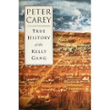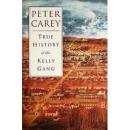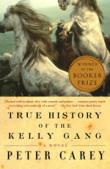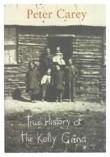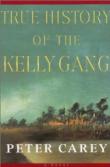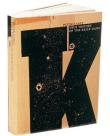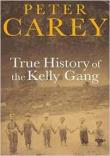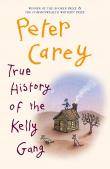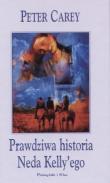AustLit
Latest Issues
AbstractHistoryArchive Description
'"I lost my own father at 12 yr. of age and know what it is to be raised on lies and silences my dear daughter you are presently too young to understand a word I write but this history is for you and will contain no single lie may I burn in Hell if I speak false."
'In TRUE HISTORY OF THE KELLY GANG, the legendary Ned Kelly speaks for himself, scribbling his narrative on errant scraps of paper in semi-literate but magically descriptive prose as he flees from the police. To his pursuers, Kelly is nothing but a monstrous criminal, a thief and a murderer. To his own people, the lowly class of ordinary Australians, the bushranger is a hero, defying the authority of the English to direct their lives. Indentured by his bootlegger mother to a famous horse thief (who was also her lover), Ned saw his first prison cell at 15 and by the age of 26 had become the most wanted man in the wild colony of Victoria, taking over whole towns and defying the law until he was finally captured and hanged. Here is a classic outlaw tale, made alive by the skill of a great novelist.' (From the publisher's website.)
Adaptations
-
form
y
 True History of the Kelly Gang
( dir. Justin Kurzel
)
Australia
:
Film4
Screen Australia
Film Victoria
Porchlight Films
,
2018
12236444
2018
single work
film/TV
True History of the Kelly Gang
( dir. Justin Kurzel
)
Australia
:
Film4
Screen Australia
Film Victoria
Porchlight Films
,
2018
12236444
2018
single work
film/TV
'Outlaw Ned Kelly lived only 25 years, but it was enough to write his story into Australian legend. The subject of countless books, songs, and other lore, he has become a near-mythical figure in the mould of Jesse James or even Robin Hood. Adapting the Booker Prize–winning novel by Peter Carey, True History of the Kelly Gang stars George MacKay, Russell Crowe, Nicholas Hoult, Essie Davis, and Charlie Hunnam in a gloriously fictionalized tale of a true-life renegade.
'Kelly (MacKay) grows up in an already rebellious Irish immigrant family, regularly bristling against the outback justice imposed by local police. Over time, he falls under the influence of Harry Power (Crowe), a true bush-ranger with little regard for colonial authority over the wild territory where he operates. Each encounter with the law pushes Kelly further and further into a dedicated life of crime. Soon enough, he's gathered a gang around him to help with the horse thieving and shootouts, and many Australian settlers are applauding his exploits. It all builds to an epic final showdown.'
Source: Toronto International Film Festival.
Reading Australia
This work has Reading Australia teaching resources.
Unit Suitable For
AC: Year 11 (English Unit 2)
Themes
19th-century Australia, Australian identity, English–Irish tensions and conflict, folklore, heroes, lawlessness, loyalty, Oppression and victimisation, policing and the law, rebellion, villains, violence
General Capabilities
Critical and creative thinking, Ethical understanding, Information and communication technology, Intercultural understanding, Literacy
Publication Details of Only Known VersionEarliest 2 Known Versions of
Other Formats
- Large print.
- Sound recording.
Works about this Work
-
Fiction and Fakements in Colonial Australia
2020
single work
criticism
— Appears in: Postcolonial Studies , September vol. 23 no. 3 2020; (p. 360-370)'The imaginations of convicts in Australia became attuned to the pairing of opposites and this led to strange tensions in their way of representing things. On Norfolk Island the meanings of words were reversed, so that ‘good’ meant ‘bad’ and ‘ugly’ meant ‘beautiful’. This undermining of official meanings produced the argot called the ‘flash’ or ‘kiddy’ language of the colony. Designed at first to keep private sentiments from being inspected, it eventually supported a system of dissident actions called ‘cross-work’ or ‘cross doings’. One word loomed large amidst these inversions: ‘fakement’, meaning booty, forgery or deceit. The verb has more extensive meanings: rob, wound, shatter; ‘fake your slangs’ means break your shackles. It also meant performing a fiction and accepting the consequences of it.' (Publication abstract)
-
Australien
2019
single work
criticism
— Appears in: Verdenslitteraturer : Introduktion til litteraturen uden for Europa 2019; (p. 253-284) -
Contemporary Interpretations of the Ned Kelly Legend : A Comparative Study of Sister Kate and True History of the Kelly Gang
内德·凯利传说的当代阐释:《凯特妹妹》与《凯利帮真史》的比较分析
2017
single work
criticism
— Appears in: Foreign Literature , vol. [2017] no. 4 2017; (p. 36-45)'Sister Kate and True History of the Kelly Gang are two important rewritings of the Ned Kelly Legend—an indispensable part of Australian collective memory. Both novels aim to rewrite history: Sister Kate focuses on deploring the unfair treatment of women in the nationalist history, whereas True History places emphasis on disclosing the operations behind the colonialist historiography. Both can be viewed as postcolonial rewritings: Sister Kate is primarily keen on bringing to light the catastrophic consequences under the colonial rule, while True History centers on the colonized Other’s fighting back. They are both involved in subverting the facade of masculinity. To attain this goal, Sister Kate reveals a series of aggressive exclusion on the part of the Kelly Gang, while True History focuses on the phenomenon of cross-dressing. A comparative study of both novels helps to explicate different writers’ concerns and approaches in their reshaping of Australian collective memory.'
Source: CAOD.
-
Memories and Their Literary Representations : A Comparative Reading of Red Sorghum and True History of the Kelly Gang
2017
single work
criticism
— Appears in: Comparative Literature Studies , vol. 54 no. 1 2017; (p. 177-194)'Mo Yan and Peter Carey are internationally acclaimed writers who have written a number of historical novels. They share many similarities in their characterization and narrative skills as they subvert official narrative memories; however, they differ in their explorations of their respective national psyches. Mo Yan's Red Sorghum and Carey's True History of theKelly Gang represent memories of historical events and figures which depict their bandits, Yu Zhan'ao (Red Sorghum) and Ned Kelly (Kelly Gang), as heroes in dark and turbulent periods. This article suggests that these characters are a reflection of the cruel histories that Chinese and Australian peoples have experienced in fighting against their enemies. Through Mo Yan and Carey's literary representation of memories within the characters of Zhan'ao and Kelly, the aesthetic value of the fiction brings the histories to life.' (Publication abstract)
-
Discarding the Disclaimer? Reappraising Fiction as a Mode of Biography
2016
single work
criticism
— Appears in: TEXT : Journal of Writing and Writing Courses , April vol. 20 no. 1 2016; 'While the biographical novel has created an openness to representing lives in fiction it is usually expected to provide a disclaimer certifying the work’s unreliability despite its potential for truth-telling and rich tools for writers wishing to tell the stories of real people. Even so, more serious attention to the historical novel since Lukács, the impact of the postmodern novel, plus the variety of published works that have adopted fictional strategies to tell lives over the last half century suggest this perspective is shifting. Using Ina Schabert’s seminal work on fictional biography as a scholarly reference point, this paper explores fiction’s biographical capacity, turning to published works and personal writing practice to try to reappraise the potential of fiction as a mode of biography.' (Publication abstract)
-
[Review] True History of the Kelly Gang
2002
single work
review
— Appears in: JASAL , vol. 1 no. 2002; (p. 96-101)
— Review of True History of the Kelly Gang 2000 single work novel -
Two Sides to the Story : For
2003
single work
review
— Appears in: The Sydney Morning Herald , 7-8 June 2003; (p. 16)
— Review of True History of the Kelly Gang 2000 single work novel -
Two Sides to the Story : Against
2003
single work
review
— Appears in: The Sydney Morning Herald , 7-8 June 2003; (p. 16)
— Review of True History of the Kelly Gang 2000 single work novel -
Wild Colonial Boy
2001
single work
review
— Appears in: The New York Review of Books , 29 March vol. 48 no. 5 2001; (p. 15-16)
— Review of True History of the Kelly Gang 2000 single work novel -
Immediately Engaging
2003
single work
review
— Appears in: Dotlit : The Online Journal of Creative Writing , August vol. 4 no. 1 2003;
— Review of True History of the Kelly Gang 2000 single work novel -
Turning the Publishing Page
2003
single work
criticism
— Appears in: The Courier-Mail , 25 January 2003; (p. 8) -
Running in the Family : Novels, Films and Nations
Andrea Stretton
(interviewer),
2002
single work
interview
— Appears in: The Sydney Papers , Autumn vol. 14 no. 2 2002; (p. 9-23) Discussion between Thomas Keneally and Michael Ondaatje, held at the Sydney Institute 8 March 2002 and moderated by Andrea Stretton. -
Hunting Ned
2003
single work
criticism
— Appears in: The Courier-Mail , 1 March 2003; (p. 5) -
Ned's Full Metal Jacket Fits Heath
2002
single work
column
— Appears in: The Sydney Morning Herald , 14 June 2002; -
The Voice of the Teller: A Conversation with Peter Carey
Nathanael O'Reilly
(interviewer),
2002
single work
interview
— Appears in: Antipodes , December vol. 16 no. 2 2002; (p. 164-167)
Awards
- 2002 winner One Book One Brisbane
- 2002 shortlisted International IMPAC Dublin Literary Award
- 2002 inaugural winner Festival Awards for Literature (SA) — Dymocks Booksellers National Fiction Award
- 2002 winner Festival Awards for Literature (SA) — Premier's Award for the Best Overall Published Work
- 2001 winner The Age Book of the Year Award — Book of the Year
- Bush,
- Country towns,

